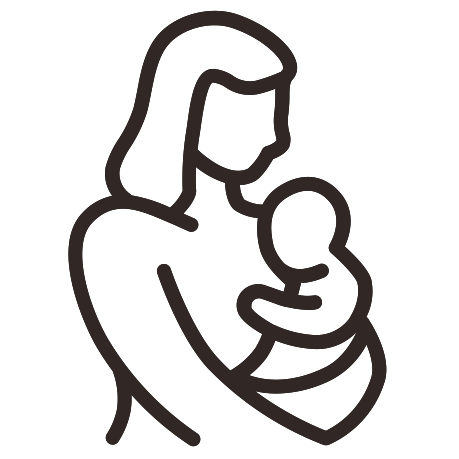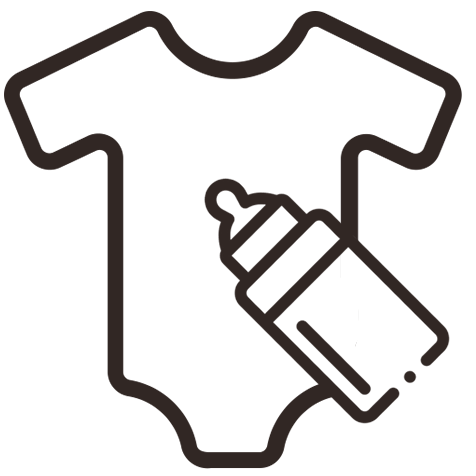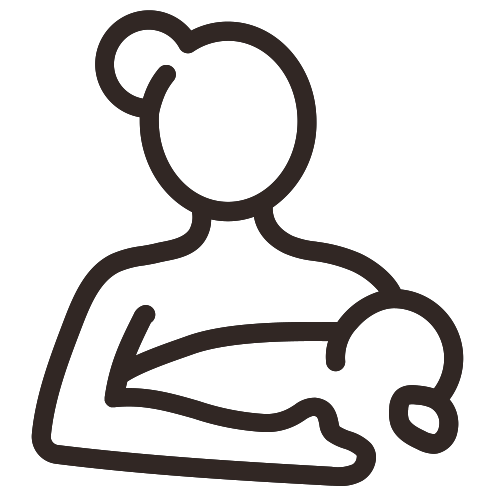The first 24 hours at home with your baby
Congratulations on the birth of your baby and welcome home! To get through the first hours/night at home without a maternity nurse, we have written down the most important information and tips below. If you come home in the evening, you can let us know that you are home until 10 p.m. If you come home later in the evening or at night, call us in the morning from 7:00 am so that we can arrange maternity care for that day. If you have created a Babybalance account, you will find useful instructional videos there. If you have any questions, you can of course call us 024-309 48 00. If you have any urgent questions or concerns, please call your midwife.
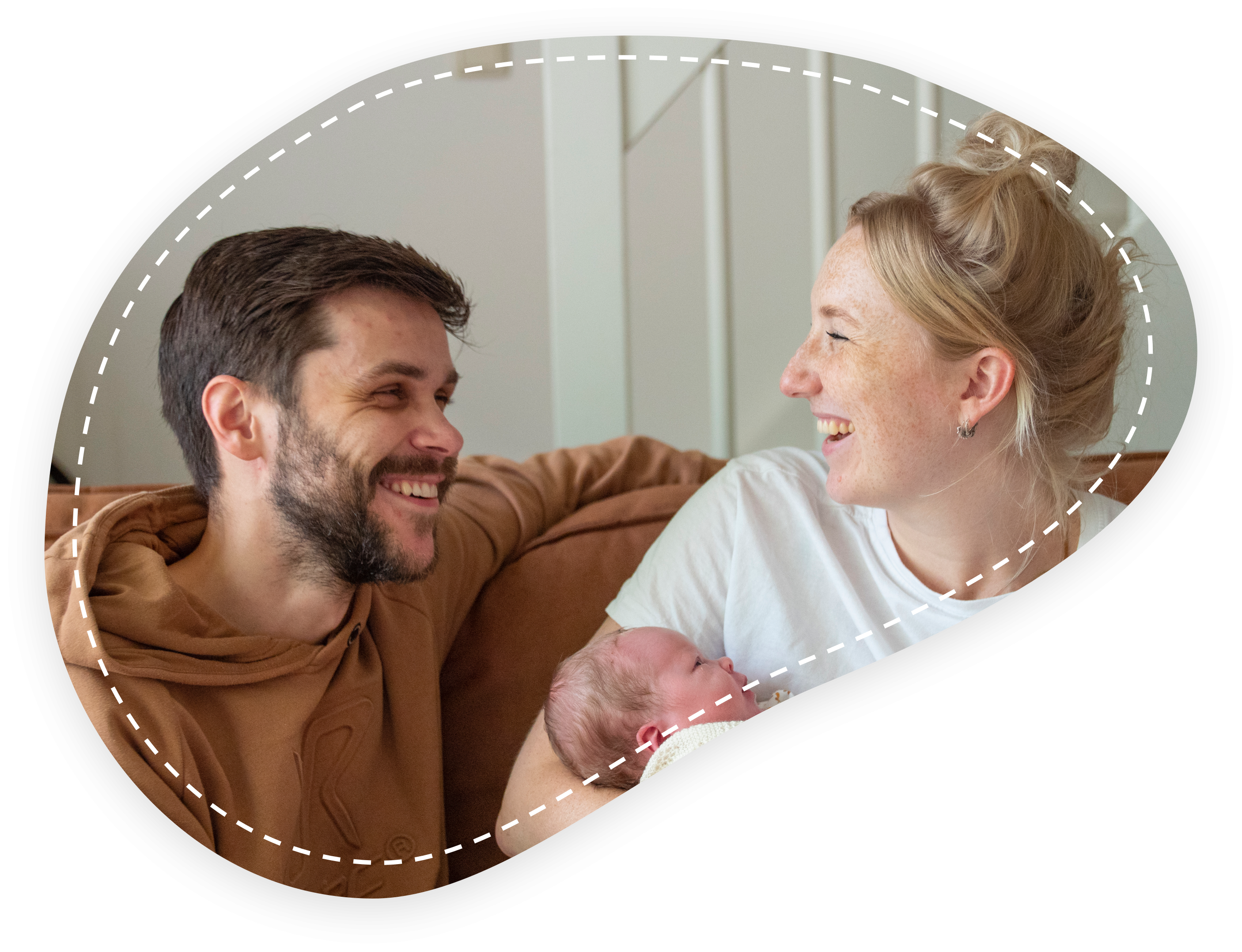
Tips for your newborn baby
Make sure the temperature in your house is not too cold (+/- 20 °C) and use a shawl to keep the baby warm when he is not in bed. Go to the toilet before every feeding and change your maternity towels. Change and temperature the baby before every feeding. The baby is then breastfed or given formula. After feeding, put the baby in his crib with the correct number of hot water bottles. Read more about headaches in babies and the umbilical stump under other tips.
It is important that the baby has a good temperature. A baby who is too cold will expend a lot of energy trying to keep himself warm. As a result, there is less energy to be awake, eat well and grow. The temperature in the womb is 37 °C, so even in the summer when we are warm, most children will need hot water bottles or a hat to maintain their temperature.
- Measure the baby’s temperature every time you change the diaper. You do this with a thermometer in the baby’s bottom (rectal).
- Take the baby’s temperature when you get home. The baby often cools down during the ride home.
Baby’s temperatures
Temperature the baby before every feeding.
- Open the diaper and let it lie under the buttocks.
- Before you start taking the temperature, put the tip of the thermometer in the Vaseline, so that the thermometer goes into the bottom a little more smoothly.
- Wait until you hear a beep (or until the thermometer stops flashing).
- Set the thermometer aside. Clean the bottom with a wipe and dress the baby again. Clean the thermometer with a piece of cotton wool moistened with alcohol. Both are included in the maternity package. Put the clean thermometer back in the case.
- The baby’s temperature should be between 36.5°C and 37.5°C.
- Record the temperature in the (digital) maternity file.
- In newborn babies, blood circulation is not yet good. As a result, they often have cold hands and feet. They may also look a bit blue. The baby often sleeps with his hands hidden from under the covers, which can cause his hands to feel cold more quickly. This is normal.
- The baby generally cannot keep warm during the first night(s) and needs a hot water bottle.
Change the baby before every feeding.
- Open the diaper and clean the baby’s bottom.
- The first poop is called meconium. It looks black and sticky.
- Remove the dirty diaper and set it aside. Slide the new diaper under the baby’s bottom.
- Close the diaper and check that it is not too tight or too loose. If two fingers can fit between the diaper and the baby’s belly, then it is fine. Make sure that the edges of the diaper at the legs point outwards.
Record pee and poop diapers in the (digital) maternity file.
- In the first few days, the urine may be concentrated because the baby is not yet consuming much food. This may cause urates to be present in the diaper. These are orange/red spots.
- Girls may have white or clear discharge. You can wipe this away a bit. From front to back (swipe towards the anus) Girls can also experience a so-called pseudomenstruation due to the loss of hormones. This means that a small amount of blood comes out of the vagina. This is normal.
- Always keep the diapers for the maternity nurse, who can then check how the urination and defecation are going.
(First) breastfeeding
- Feed the baby on demand (if the baby searches for his hands or makes smacking sounds, this is a sign that he wants to drink). In any case, wake the baby after about 3 hours to feed again.
- Offer both breasts and start each feeding with the breast you stopped feeding.
- If the installation does not work, this is not a problem. Try again when the baby cries or after 3 hours.
- If the baby is restless after feeding, you can put him back on the breast you last fed.
- Breastfeeding shouldn’t hurt. If you are in pain, it may be that your baby has not latched properly. Remove your baby from the breast by breaking the vacuum with your little finger and try to induce latching again.
Points to consider when installing
- Make sure you are relaxed and well supported.
- Place the baby belly to belly and ensure that he is positioned so that the nipple is at the level of the upper lip/nose.
- Let the baby take a big bite. So he must not only have the nipple but also part of the areola in his mouth.
- When the baby is properly at the breast, you will see that the nose is clear of the breast. The lips are curled outwards and he has chubby cheeks. You hear no sound, except swallowing and breathing.
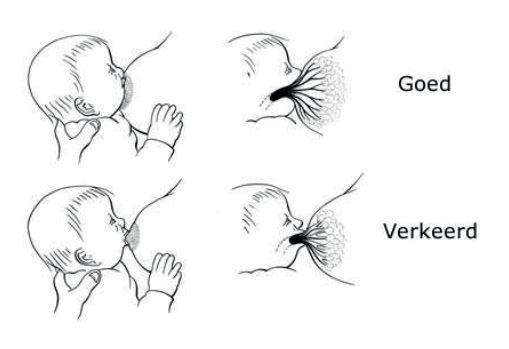
You can prepare the food according to the instructions on the packaging. On the first day, the baby drinks approximately 10-20 ml per feeding. Make sure you have a clean bottle. And wash your hands before making the food.
Make and give a bottle
- Prepare a bottle
- Warm up 30 ml of cold water from the tap by briefly placing the bottle in a mug of hot water. You can also put it in the microwave on low power. Make sure it doesn’t get too hot. The water must be at body temperature (37° C).
- Add 1 level scoop of powdered food (per 30 ml of water) and swirl the bottle or stir gently with a fork or knife. Do not shake, as this will introduce extra air into the milk. NB. The ratio of water to milk powder is almost always 30ml of water to 1 scoop of powdered food. (For some brands 60 ml with 1 scoop. Check the packaging for this). Do not use half scoops.
- Check the temperature of the milk on your wrist. Better to be a little too cold than too hot.
- Give the bottle at the time given to you by the hospital. Or offer at your baby’s request. On the first day, your baby needs 10 ml of food at a time. The second day 20 ml etc. Do not give too much food.
- Make sure that the teat of the bottle is always filled with food so that your baby does not swallow too much air while drinking.
- Burp your baby by holding him upright.
- Throw away the milk that remains, it should not be stored and reheated.
Note in the (digital) maternity file how much the baby has drunk.
Cleaning the bottle
- Boil the bottle before first use. Place the bottle in a pan of water. Cover with water and bring to the boil. Let it simmer gently for 5 minutes. Weaning 3 minutes. Place everything on a clean tea towel to dry.
- The following feedings you can rinse the bottle and teat with cold water. Use a bottle brush for this.
- Rinse with warm water.
- Place all parts upside down on a clean tea towel or in a bottle rack.
After feeding, put the baby in his crib with the correct number of baby bottles.
- Place the pitcher in the sink.
- Put a little bit of cold water in the pitcher.
- Fill the pitcher completely with boiled water. Air in the hot water bottle increases the risk of leaks, so make sure it is completely filled until a bulge is visible.
- Turn the cap slightly counterclockwise until it fits into the thread. Then you close it. Use a dry kitchen towel to tighten the cap securely.
- Dry the hot water bottle and place it on the counter to check that the hot water bottle is not leaking.
- Roll a hydrophilic (fabric) diaper around the hot water bottle and tie a knot in it.
- Hot water bottles are always placed within a hand’s width of the baby.
- Always place the hot water bottles ABOVE the blanket and cover them with a second blanket or shawl.
- This way the hot water bottle cannot roll against your baby and it stays warm.
Note: If you have a (narrow) cradle, only place a hot water bottle at the feet. Make sure that the hot water bottle cannot roll against the baby.
Note: If you have an Aerosleep mattress in the bed, it must be removed from the bed when you place a hot water bottle in it. If the hot water bottle leaks, the water cannot escape on an Aerosleep. The mattress also provides more ventilation and therefore more cold air under the baby.
Note: Choose 1 thing at a time from the table at a higher temperature. Remove either the hot water bottle or the blanket, but not both at the same time. One hour after making any changes, check the temperature again at low or high temperature. Consult with your midwife if you have a persistently low or high temperature.
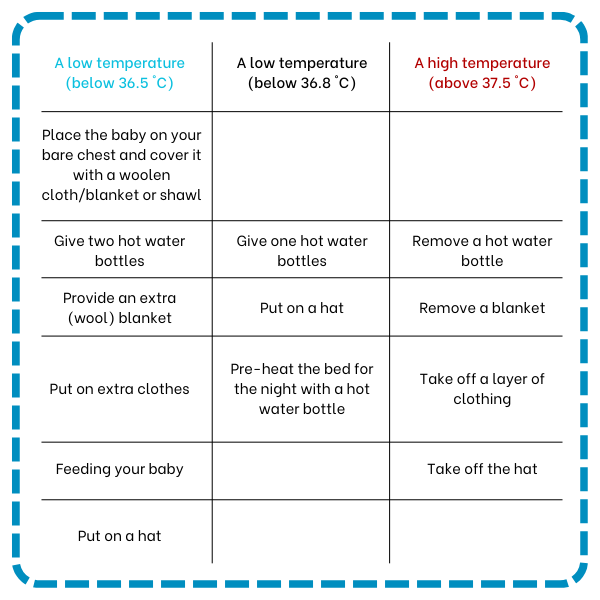
Sleeping position in bed
- Always put the baby to sleep on his back, so put him on his back to bed from birth. Because the face is then free, the baby can breathe well. That’s the safest.
- Place the baby on his back in the crib and alternately turn his face to the left and right. This helps prevent a preferential position.
- The baby sleeps most safely in a crib or bed. The baby bed is preferably in the parents’ room (rooming-in)
- Don’t dress your baby too cold or too warm. You can feel by the neck whether the baby is too hot or too cold. It should feel nice and warm.
Important: During delivery, some blood and mucus may enter the baby’s mouth and stomach. Your baby may still be very nauseous during the first 48 hours after birth. The baby may have to gag or spit up. Wipe away the spit with a cloth or gauze. The supine position is the safest, but if you notice that your baby is very nauseous and is spitting up often, you can place your baby on the side for a while. With a rolled up hydrophilic cloth in the back. It may happen that the baby is so nauseous that he does not want to drink. This is not a problem on the first day and the maternity nurse will explain this. Spit is usually clear or white/yellow. This depends on the baby’s diet. Sometimes spit can also be brown. This is normal, don’t be alarmed by this.
Changing your baby
- Before every feeding, change and temperature the baby.
- Open the diaper and clean the baby’s bottom.
- The first poop is called meconium. It looks black and sticky.
- Remove the dirty diaper and set it aside. Slide the new diaper under the baby’s bottom.
- Close the diaper and check that it is not too tight or too loose. If two fingers can fit between the diaper and the baby’s belly, then it is fine. Make sure that the edges of the diaper at the legs point outwards.
Record pee and poop diapers in the (digital) maternity file.
- In the first few days, the urine may be concentrated because the baby is not yet consuming much food. This may cause urates to be present in the diaper. These are orange/red spots.
- Girls may have white or clear discharge. You can wipe this away a bit. From front to back (swipe towards the anus) Girls can also experience a so-called pseudomenstruation due to the loss of hormones. This means that a small amount of blood comes out of the vagina. This is normal.
- Always keep the diapers for the maternity nurse, who can then check how the urination and defecation are going.
Go to the toilet before every feeding and change your maternity towels.
- Make sure you urinate regularly, preferably before each feeding. An empty bladder allows the uterus to contract better.
- During the first 24 hours at home, do not go to the toilet alone and never lock the door. You may still feel light-headed in the first few days when you go to the toilet or take a shower. It is important that there is someone nearby and that they can also come and help you if something is wrong.
- Change your maternity pad(s).
- You may have quite a lot of flow in the first few days after giving birth, comparable to a heavy menstrual period. It is normal for your maternity pad to be completely soaked with blood every 3 hours. Change your maternity towel every time you go to the toilet. You can also lose a blood clot the size of a fist. This is normal.
Note: If you have to change your sanitary towels twice within half an hour, or lose 2 fist-sized clots, contact the midwife.
- Wash your hands.
- You may suffer from after-effects after giving birth. After-effects are useful: they ensure that the uterus returns to its old shape. After-contractions feel like menstrual-like pain. You may take paracetamol (maximum 2 tablets 4 times a day).
- After urinating, rinse the vagina with lukewarm water. This can be done with a clean bottle or water bottle in the toilet or you can urinate in the shower.
Headache in the baby
After a birth with the aid of a vacuum pump or forceps, the baby may have a headache or be nauseous. Give your baby as much rest as possible. Place the baby in its own bed or on your or your partner’s chest as much as possible and limit visits.
Umbilical stump
The navel may still bleed a little. This is normal. If the bleeding increases, call the midwife.

